The Hemorrhagic stroke Treatment Market is estimated to be valued at USD 3.7 billion in 2025 and is projected to reach USD 6.8 billion by 2035, registering a compound annual growth rate (CAGR) of 6.2% over the forecast period.
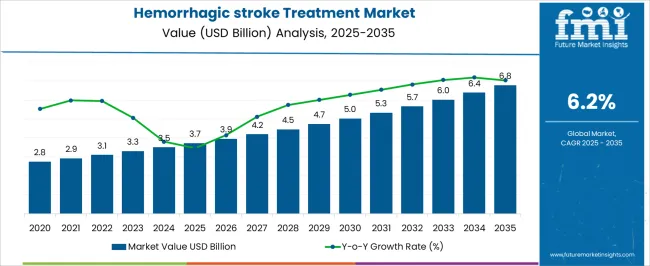
| Metric | Value |
|---|---|
| Hemorrhagic stroke Treatment Market Estimated Value in (2025 E) | USD 3.7 billion |
| Hemorrhagic stroke Treatment Market Forecast Value in (2035 F) | USD 6.8 billion |
| Forecast CAGR (2025 to 2035) | 6.2% |
The Hemorrhagic Stroke Treatment market is experiencing steady expansion as healthcare systems increasingly prioritize timely intervention strategies for stroke patients. The current scenario reflects rising incidences of intracerebral and subarachnoid hemorrhages globally, fueled by factors such as aging populations, hypertension prevalence, and lifestyle-related risks. This has resulted in greater emphasis on accessible treatment options that combine rapid drug administration, advanced surgical procedures, and rehabilitative care.
Increasing adoption of evidence-based clinical guidelines has ensured wider acceptance of structured treatment regimens, while ongoing research in neuroprotective drugs and minimally invasive surgical techniques continues to broaden the therapeutic landscape. Hospital infrastructure upgrades and the integration of digital health platforms into stroke management protocols are contributing to enhanced patient outcomes.
Future outlook is shaped by increasing investments in clinical innovation, greater penetration of specialized stroke units, and continued awareness campaigns for early diagnosis As treatment ecosystems expand, market growth is expected to be reinforced by government support, payer reimbursement models, and the adoption of personalized care pathways.
The hemorrhagic stroke treatment market is segmented by treatment type, distribution channel, and geographic regions. By treatment type, hemorrhagic stroke treatment market is divided into Therapeutic (Drugs), Antihypertensive, Anticonvulsant, Osmotic Diuretics, Surgery, Hematoma Removal Surgery, Endovascular Repair, and Aneurysm Clipping. In terms of distribution channel, hemorrhagic stroke treatment market is classified into Hospitals, Specialty Clinics, Ambulatory Surgery Center, Hospital Pharmacies, Retail Pharmacies, and Others. Regionally, the hemorrhagic stroke treatment industry is classified into North America, Latin America, Western Europe, Eastern Europe, Balkan & Baltic Countries, Russia & Belarus, Central Asia, East Asia, South Asia & Pacific, and the Middle East & Africa.
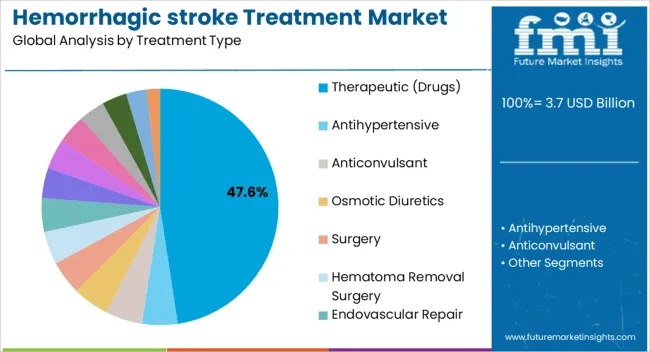
The Therapeutic drugs segment is projected to hold 47.60% of the overall Hemorrhagic Stroke Treatment market revenue in 2025, making it the leading treatment type. This position is being driven by the essential role that pharmacological therapies play in controlling secondary complications, stabilizing blood pressure, and minimizing risks of rebleeding or clot formation.
Widespread availability of antihypertensives, anticoagulant reversal agents, and neuroprotective medications has facilitated faster access to treatment across diverse healthcare settings. Growth of this segment has been reinforced by the increasing demand for immediate, non-invasive options that can be administered in emergency scenarios to stabilize patients before or alongside surgical interventions.
Furthermore, advancements in drug delivery systems and the development of targeted therapies aimed at improving cerebral blood flow and minimizing neuronal damage have supported adoption As healthcare providers continue to emphasize cost-effective and accessible treatment approaches, therapeutic drugs are expected to retain their prominence, supported by their critical role in early intervention and ongoing patient management.
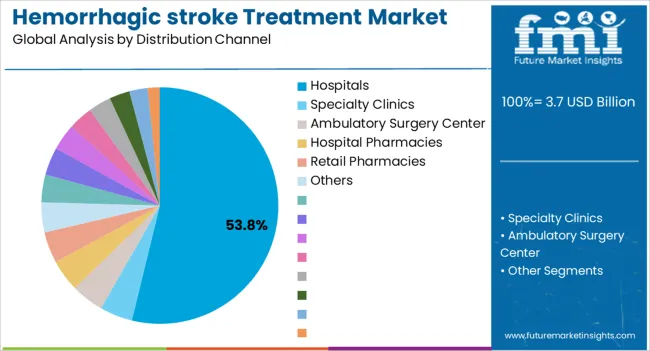
The Hospitals distribution channel is anticipated to capture 53.80% of the Hemorrhagic Stroke Treatment market revenue in 2025, positioning it as the largest channel for patient care delivery. This dominance is being supported by the concentration of specialized infrastructure, including dedicated stroke units, neurosurgical teams, and advanced diagnostic capabilities. Hospitals serve as the primary point of care for emergency admissions, where immediate access to imaging technologies and intensive care resources is vital for managing hemorrhagic strokes.
Increased government and private sector investments in hospital-based stroke care centers, combined with accreditation programs promoting quality standards, have strengthened the reliance on hospitals for treatment delivery. Moreover, the availability of multidisciplinary teams enables comprehensive care that integrates acute intervention, surgical treatment, and rehabilitation planning under one roof.
With growing emphasis on rapid response protocols and coordinated care pathways, hospitals remain indispensable in ensuring survival and recovery outcomes Continued expansion of tertiary care centers, coupled with rising patient preference for structured institutional care, is expected to sustain the segment’s leadership.
A stroke is a recurring condition which happens when there is imbalance in the blood supply to the brain either because of rupture of blood vessels or a blood clot, which can lead to mortality of cerebrum cells or a brain death. A hemorrhagic stroke happens when the blood loss is inside brain, sudden bleeding which occurs within the brain or between the brain and the skull bone, although hemorrhagic stroke holds higher mortality rate compare to other type of strokes. Hemorrhagic stroke Treatment usually involves monitoring and lowering the blood pressure. The Hemorrhagic stroke Treatment also constitutes surgical intervention to lower the blood pressure, typically a devices known as ventriculostomy tube is inserted into the ventricle and drainage of blood from the brain is achieved.
The Hemorrhagic stroke Treatment facilitate rapid recovery and elimination of further damage to the brain. The minimal risk of surgical intervention in surrounding of the brain is achieved through the use of technique called “burr hole” by Hemorrhagic stroke Treatment. Additionally, the haemostasis is achieved with the help of endovascular repair. The time required in receiving Hemorrhagic stroke Treatment plays a major role in survival of hemorrhagic stroke patient. The Hemorrhagic stroke Treatment offers primal advantage in selection of procedures and drugs according to the severity of the hemorrhagic stroke condition.
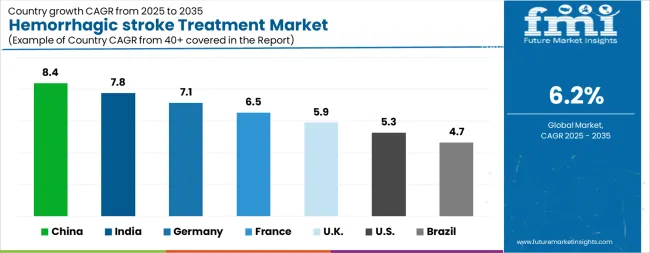
| Country | CAGR |
|---|---|
| China | 8.4% |
| India | 7.8% |
| Germany | 7.1% |
| France | 6.5% |
| UK | 5.9% |
| USA | 5.3% |
| Brazil | 4.7% |
The Hemorrhagic stroke Treatment Market is expected to register a CAGR of 6.2% during the forecast period, exhibiting varied country level momentum. China leads with the highest CAGR of 8.4%, followed by India at 7.8%. Developed markets such as Germany, France, and the UK continue to expand steadily, while the USA is likely to grow at consistent rates. Brazil posts the lowest CAGR at 4.7%, yet still underscores a broadly positive trajectory for the global Hemorrhagic stroke Treatment Market. In 2024, Germany held a dominant revenue in the Western Europe market and is expected to grow with a CAGR of 7.1%. The USA Hemorrhagic stroke Treatment Market is estimated to be valued at USD 1.3 billion in 2025 and is anticipated to reach a valuation of USD 2.2 billion by 2035. Sales are projected to rise at a CAGR of 5.3% over the forecast period between 2025 and 2035. While Japan and South Korea markets are estimated to be valued at USD 194.8 million and USD 120.3 million respectively in 2025.
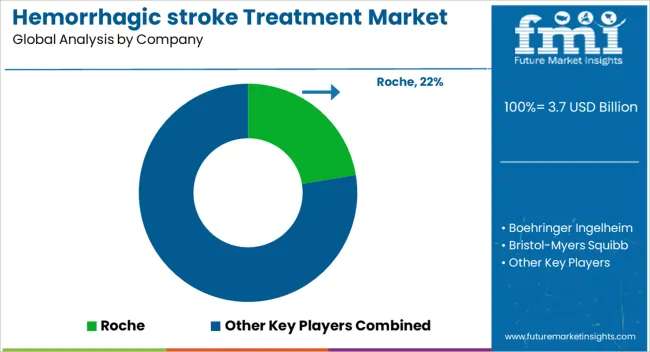
| Item | Value |
|---|---|
| Quantitative Units | USD 3.7 Billion |
| Treatment Type | Therapeutic (Drugs), Antihypertensive, Anticonvulsant, Osmotic Diuretics, Surgery, Hematoma Removal Surgery, Endovascular Repair, and Aneurysm Clipping |
| Distribution Channel | Hospitals, Specialty Clinics, Ambulatory Surgery Center, Hospital Pharmacies, Retail Pharmacies, and Others |
| Regions Covered | North America, Europe, Asia-Pacific, Latin America, Middle East & Africa |
| Country Covered | United States, Canada, Germany, France, United Kingdom, China, Japan, India, Brazil, South Africa |
| Key Companies Profiled | Roche, Boehringer Ingelheim, Bristol-Myers Squibb, Johnson & Johnson, Daiichi Sankyo Co. Ltd., AstraZeneca, Biogen, SanBio Co Ltd, AthersysInc., Abbott, Merck, Pfizer, Novartis AG, Sanofi S.A., and Medtronic |
The global hemorrhagic stroke treatment market is estimated to be valued at USD 3.7 billion in 2025.
The market size for the hemorrhagic stroke treatment market is projected to reach USD 6.8 billion by 2035.
The hemorrhagic stroke treatment market is expected to grow at a 6.2% CAGR between 2025 and 2035.
The key product types in hemorrhagic stroke treatment market are therapeutic (drugs), antihypertensive, anticonvulsant, osmotic diuretics, surgery, hematoma removal surgery, endovascular repair and aneurysm clipping.
In terms of distribution channel, hospitals segment to command 53.8% share in the hemorrhagic stroke treatment market in 2025.






Our Research Products

The "Full Research Suite" delivers actionable market intel, deep dives on markets or technologies, so clients act faster, cut risk, and unlock growth.

The Leaderboard benchmarks and ranks top vendors, classifying them as Established Leaders, Leading Challengers, or Disruptors & Challengers.

Locates where complements amplify value and substitutes erode it, forecasting net impact by horizon

We deliver granular, decision-grade intel: market sizing, 5-year forecasts, pricing, adoption, usage, revenue, and operational KPIs—plus competitor tracking, regulation, and value chains—across 60 countries broadly.

Spot the shifts before they hit your P&L. We track inflection points, adoption curves, pricing moves, and ecosystem plays to show where demand is heading, why it is changing, and what to do next across high-growth markets and disruptive tech

Real-time reads of user behavior. We track shifting priorities, perceptions of today’s and next-gen services, and provider experience, then pace how fast tech moves from trial to adoption, blending buyer, consumer, and channel inputs with social signals (#WhySwitch, #UX).

Partner with our analyst team to build a custom report designed around your business priorities. From analysing market trends to assessing competitors or crafting bespoke datasets, we tailor insights to your needs.
Supplier Intelligence
Discovery & Profiling
Capacity & Footprint
Performance & Risk
Compliance & Governance
Commercial Readiness
Who Supplies Whom
Scorecards & Shortlists
Playbooks & Docs
Category Intelligence
Definition & Scope
Demand & Use Cases
Cost Drivers
Market Structure
Supply Chain Map
Trade & Policy
Operating Norms
Deliverables
Buyer Intelligence
Account Basics
Spend & Scope
Procurement Model
Vendor Requirements
Terms & Policies
Entry Strategy
Pain Points & Triggers
Outputs
Pricing Analysis
Benchmarks
Trends
Should-Cost
Indexation
Landed Cost
Commercial Terms
Deliverables
Brand Analysis
Positioning & Value Prop
Share & Presence
Customer Evidence
Go-to-Market
Digital & Reputation
Compliance & Trust
KPIs & Gaps
Outputs
Full Research Suite comprises of:
Market outlook & trends analysis
Interviews & case studies
Strategic recommendations
Vendor profiles & capabilities analysis
5-year forecasts
8 regions and 60+ country-level data splits
Market segment data splits
12 months of continuous data updates
DELIVERED AS:
PDF EXCEL ONLINE
Cryptogenic Stroke Treatment Market Size and Share Forecast Outlook 2025 to 2035
Brazilian Hemorrhagic Fever (BzHF) Treatment Market
Treatment-Resistant Hypertension Management Market Size and Share Forecast Outlook 2025 to 2035
Treatment-Resistant Depression Treatment Market Size and Share Forecast Outlook 2025 to 2035
Stroke Catheters Market Analysis - Size, Share, and Forecast Outlook 2025 to 2035
Treatment Pumps Market Insights Growth & Demand Forecast 2025 to 2035
Stroke Assistive Devices Market
Pretreatment Coatings Market Size and Share Forecast Outlook 2025 to 2035
VR Stroke Rehabilitation Market Insights – Growth & Trends 2023-2033
Air Treatment Ozone Generator Market Size and Share Forecast Outlook 2025 to 2035
CNS Treatment and Therapy Market Insights - Trends & Growth Forecast 2025 to 2035
Seed Treatment Materials Market Size and Share Forecast Outlook 2025 to 2035
Acne Treatment Solutions Market Size and Share Forecast Outlook 2025 to 2035
Scar Treatment Market Overview - Growth & Demand Forecast 2025 to 2035
Soil Treatment Chemicals Market
Water Treatment System Market Size and Share Forecast Outlook 2025 to 2035
Water Treatment Chemical Market Size and Share Forecast Outlook 2025 to 2035
Algae Treatment Chemical Market Forecast and Outlook 2025 to 2035
Water Treatment Market Size and Share Forecast Outlook 2025 to 2035
Water Treatment Ozone Generator Market Size and Share Forecast Outlook 2025 to 2035

Thank you!
You will receive an email from our Business Development Manager. Please be sure to check your SPAM/JUNK folder too.
Chat With
MaRIA